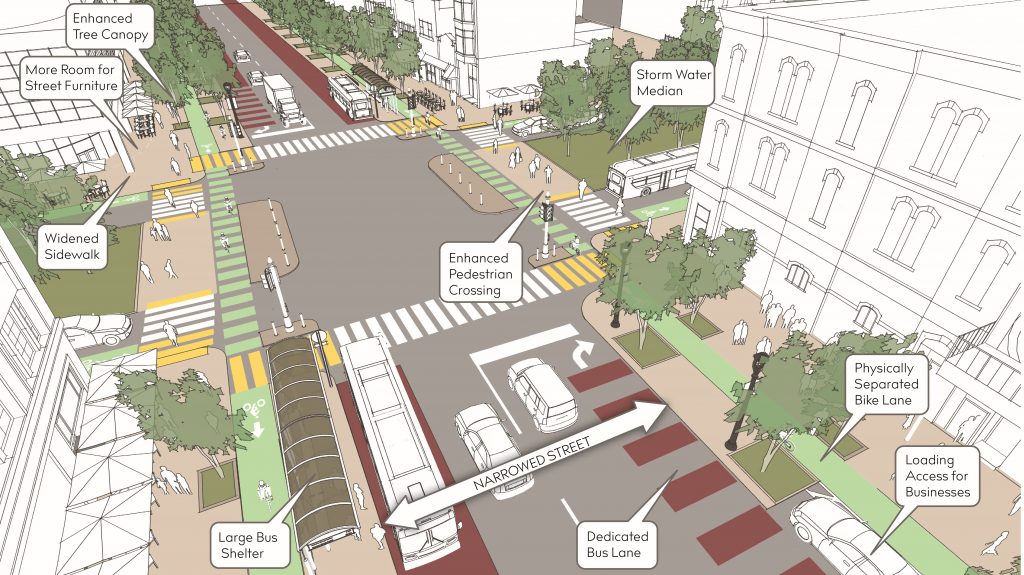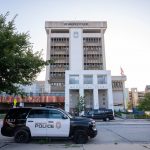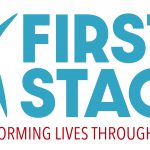Plan Would Improve Red Arrow Park, Overhaul Two Downtown Streets
And use downtown property taxes to bail out Century City TIF district.
The City of Milwaukee is looking to tap an overperforming tax incremental financing (TIF) district for $5.75 million to pay for upgrades to Red Arrow Park, redesign two downtown streets, start design work for a plaza around City Hall and cover a shortfall on the construction of Vel R. Phillips Plaza.
The plan also includes $11.75 million to bail out the Century City TIF district, which hasn’t generated enough incremental revenue to retire the debt associated with preparing the business park.
The design elements, which received their first public review Thursday, are conceptual ideas called for as part of the 2040 Downtown Plan. The board of the Redevelopment Authority of the City of Milwaukee (RACM) unanimously endorsed the proposal. The full Common Council must still review the plan.
Funding would come from the Park East TIF district, which was created in 2002 to support the demolition of the Park East Freeway spur and the construction of a new street network. The district, which must close by 2029 and cannot incur new expenses after 2024, is now generating several million dollars in annual incremental property tax revenue. Last year, the city tapped the district to cover the base cost for Vel R. Phillips Plaza and a multi-million investment in traffic calming infrastructure for the neighborhoods just northwest of Downtown.
Red Arrow Park would receive $500,000 for design work under the latest proposal. The funding, said Department of City Development economic development specialist Dan Casanova, would be allocated as part of a larger partnership with Milwaukee County Parks and Milwaukee Downtown, Business Improvement District #21. “We are looking at ways to make it more of a destination,” said Casanova. The county owns the park, which includes a skating rink and cafe, and Milwaukee Downtown hosts an increasing number of events at the park, 920 N. Water St.
The street funding would pay for design work on two four-lane downtown streets and will likely result in proposals to narrow the roadways.
A total of $1.9 million would be allocated to fund the redesign of N. Water Street between E. Kilbourn Avenue and E. Pleasant Street. “That’s an area where it goes from a two-lane road up to a four-lane road and then back down,” said Casanova. He said the widening was completed as part of the removal of the Park East Freeway spur, but has led to speeding. The recently-adopted downtown plan calls for bus-only lanes, wider sidewalks and protected bike lanes. “The funding would be for the design of [those concepts] as well as some more short-term improvements.”
A similar project is planned for W. Kilbourn Avenue from the Milwaukee River west to N. 6th Street. The four-lane street already includes a bike lane protected by plastic delineators. But the nature of the street is set to change substantially when the Baird Center is completed this spring. The convention center’s front door will face the street instead of W. Wisconsin Avenue. The TIF district would fund $1.3 million in design work and other short-term improvements. At the eastern end of Kilbourn Avenue, a district associated with Northwestern Mutual‘s expansion is funding an extension of the bike lane to the lake from N. Van Buren Street.
For both street projects, the city must identify an additional funding source to construct permanent improvements.
A conceptual plan to develop a plaza around City Hall, 200 E. Wells St., would receive $50,000 in seed funding from the district. “We spent more than $100 million renovating the building itself, but haven’t done much with the area outside of it,” said Casanova. It is another project in partnership with Milwaukee Downtown. The downtown plan contemplates a large plaza and, last year. Alderman Robert Bauman advocated for a sizable investment, but Department of Public Works officials said the plan was to start with a lower-cost temporary plaza.
The TIF proposal also includes $1.3 million for an increasingly costly new downtown park.
Vel R. Phillips Plaza, under construction atop a surface parking lot at N. Vel R. Phillips and W. Wisconsin avenues, was previously funded with $15.75 million from the Park East district and $750,000 from the TIF district created to support Fiserv’s move to downtown. Casanova attributed the latest cost increase to contaminated soils found at the site and other expenses associated with the 30,000-square-foot plaza and cafe building.
At the same meeting, the RACM board endorsed a previously announced lease agreement for Mike Eitel to operate the Nomad Coffee Bar at the site, for the greater of $5,000 per month or 6% of sales. Eitel said the cafe would “evoke some sort of European vibe” and transition throughout the day from a place to grab breakfast to a spot for lunch and ultimately into a gathering place in the evening. “He also saw the vision for what was happening in the neighborhood, which I’m not sure everyone else saw,” said Casanova of Eitel winning a bidding process.
The city, said the DCD representative, anticipates announcing the three finalists in the coming weeks for a significant public art piece that honors the late Vel Phillips, for whom the park is named. Casanova said 60 proposals were received.
The most expensive aspect of the proposal represents an explicit transfer of downtown tax revenue to an impoverished area of the city. Using a provision of state TIF law, the Park East district would have $11.75 million in future revenue transferred to cover a budget shortfall within the TIF district used to acquire, remediate and prepare the 84-acre Century City business park that was previously home to Tower Automotive.
Including four previously approved TIF district donations, a budget document indicates $23.9 million will have been transferred to the district. The district, which includes the surrounding residential neighborhood, has generated only $216,288 in incremental revenue, because of falling property values. All of that incremental revenue was generated in 2022, the first year the combined properties were assessed above the base value of the district.
Under state statute, the debt associated with the Century City district must be retired by 2036, and the district itself must be closed. Despite the financial issues, city officials have remained committed to the area. It’s central to a corridor that is now a finalist for a $50 million federal grant.
If you think stories like this are important, become a member of Urban Milwaukee and help support real, independent journalism. Plus you get some cool added benefits.
Political Contributions Tracker
Displaying political contributions between people mentioned in this story. Learn more.
- July 26, 2019 - Robert Bauman received $100 from Mike Eitel























Re corner of Water and Juneau: Remember to leave room for long trucks to make the turn while making deliveries, something they didn’t do at North and Oakland, where planters and posts have been taken out by trucks negotiating the turn.
Enough with these TIF districts. Take property tax money and put it into a general fund that is used for the benefit of all Milwaukeeans. I would love to pay property taxes used only for my property and neighborhood. Instead, people from all over the city pay property taxes that are used to make downtown a pleasant playground for people who come in to work from the suburbs. Our streets are crumbling. They damage our cars and drive down property values. There is more to Milwaukee than downtown. Century City? It is another stupid deal that taxpayers are now going to bail out. Just like Northridge. What is next, another round of big raises for those people who brought us the Northridge and Century City debacles?
Water St. was widened to 4-lanes with a center median in the 1960s before the PAC opened in 1969, decades before the Park Freeway East was razed in 2002-2003.
Making the city center more appealing and encouraging pedestrian traffic along with protected bike lanes will continue the revitalization of Milwaukee. This all looks like a great plan for the future!
Is there room for trucks and buses to make right turns without taking out the signals or a few of those white posts?